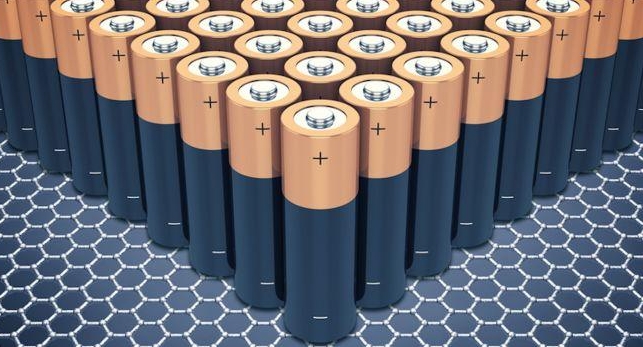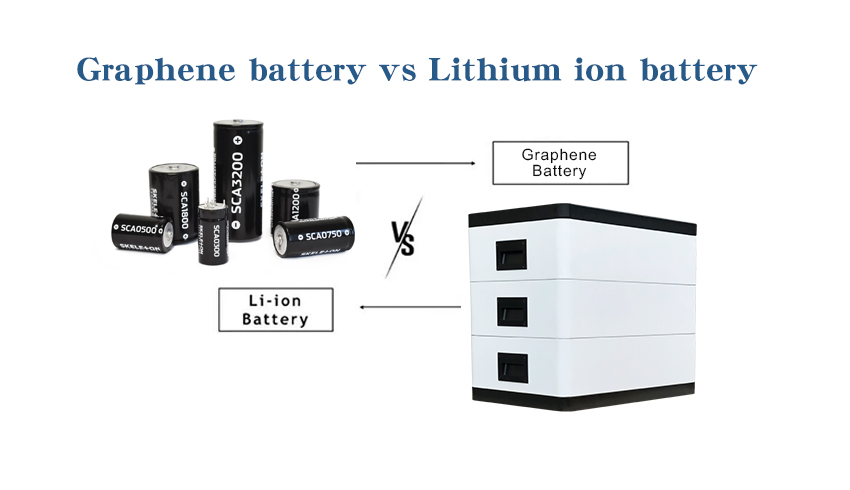С растущим спросом на эффективные и устойчивые энергетические решения, графеновые батареи и литиевые батареи стали двумя долгожданными конкурентами.
Однако, какой из них больше подходит для ваших нужд?
Ищете ли вы подходящие источники питания для электромобилей?, смартфоны, или системы возобновляемой энергии, в этом руководстве будут рассмотрены их основные преимущества., ограничения, и перспективы дальнейшего развития, которые помогут вам сделать правильный выбор.
Что такое графеновая батарея?

Состав графеновой батареи
Графеновая батарея — это устройство хранения энергии, в котором графен используется в качестве основного материала..
Графен представляет собой однослойный материал, состоящий из атомов углерода, расположенных в сотовой решетчатой структуре., который привлек большое внимание своей превосходной электропроводностью и механической прочностью..
В графеновых батареях, графен обычно используется в качестве материала электрода., который вместе с электролитами и другими дополнительными материалами образует основную структуру батареи..
Графеновые батареи стали идеальной альтернативой традиционным аккумуляторным технологиям благодаря своим значительным преимуществам., главным образом отражается в следующих аспектах:
Возможность быстрой зарядки:
Графеновые батареи обладают отличными характеристиками зарядки и обеспечивают быструю зарядку..
Эта функция особенно важна в таких приложениях, как электромобили и портативные электронные устройства, требующие быстрого пополнения энергии..
Высокая плотность энергии:
Плотность энергии графеновых батарей намного выше, чем у традиционных литиевых батарей., это означает, что графеновые батареи могут хранить больше энергии при той же массе и объеме..
Это не только продлевает срок службы батареи устройства., но и повышает общую эффективность.
Длительный срок службы:
Высокая прочность и устойчивость графена к деградации значительно продлевают срок службы его батарей..
Более длительный срок службы означает меньшую частоту замены батареи., что является более экономичным решением в долгосрочной перспективе.
Повышенная безопасность:
Графеновые батареи имеют более высокую стабильность и менее склонны к тепловому выходу из строя..
Термический разгон является основной причиной возгорания или взрыва традиционных литиевых батарей., в то время как преимущество графеновых батарей делает их более безопасными в таких приложениях, как электромобили и системы хранения энергии..
Экологичность:
В качестве материала на основе углерода, применение графена в батареях способствует устойчивому развитию окружающей среды.
По сравнению с традиционными батареями, в которых используются токсичные элементы, графеновые батареи — более чистый и экологически чистый вариант.
Что такое литиевая батарея?
Литиевые батареи — это перезаряжаемые устройства хранения энергии., с их положительными и/или отрицательными электродами, состоящими в основном из соединений лития..
Принцип его работы основан на движении ионов лития вперед и назад между положительным и отрицательным электродами во время процессов зарядки и разрядки..
Литий-ионные аккумуляторы (Литий-ионный) являются наиболее распространенным типом литиевой батареи, широко используется в портативных электронных устройствах, электрические транспортные средства, и системы хранения возобновляемой энергии.
Литиевые аккумуляторы пользуются большим спросом благодаря своим многочисленным преимуществам.:
Высокая плотность энергии:
Литиевые батареи известны своей высокой плотностью энергии и способностью хранить большое количество энергии в компактном объеме..
Эта особенность делает его идеальным выбором для применений, требующих чрезвычайно больших размеров и веса., например, смартфоны и ноутбуки.
Длительный цикл жизни:
Литиевые батареи имеют длительный срок службы при зарядке-разрядке и могут сохранять высокую емкость даже после многократного использования..
Это означает, что они могут сохранять производительность в течение более длительного периода времени., тем самым уменьшая частоту замены.
Легкий дизайн:
По сравнению со многими другими аккумуляторами, литиевые батареи легче по весу, что обеспечивает значительные преимущества для их применения в портативных устройствах..
Легкая конструкция повышает мобильность и удобство использования устройства..
Высокая скорость разряда:
Литиевые батареи могут быстро выдавать большие токи, что имеет решающее значение для приложений, требующих мгновенной высокой мощности, такие как электромобили, электроинструменты, и высокопроизводительное оборудование.
Зрелая технология:
Литиевые батареи прошли обширные исследования и разработки., и их технология стала очень зрелой.
Его крупномасштабное применение привело к экономической эффективности., сделать литиевые батареи более доступными и популярными.
Графеновая батарея против литий-ионной батареи
Сравнение графеновых батарей и литий-ионных батарей можно провести с нескольких аспектов., и ниже приводится всестороннее сравнение двух:
1. Плотность энергии
Графеновый аккумулятор:
Имеет более высокую плотность энергии, теоретически в несколько раз больше, чем у литиевых батарей.
Например, удельная энергия графеновых батарей может достигать 600 Втч/кг, намного выше, чем 180 Втч/кг литиевых батарей.
Литиевая батарея:
Плотность энергии относительно низкая., но он широко используется в электромобилях и портативных устройствах..
2. Скорость зарядки
Графеновый аккумулятор:
Быстрая скорость зарядки, может завершить зарядку за короткое время.
Например, Графеновую батарею емкостью 3000 мАч можно зарядить почти до половины емкости всего за 5 минуты.
Литиевая батарея:
Скорость зарядки относительно медленная, особенно в условиях низких температур, и эффективность зарядки еще больше снизится.
3. Цикл жизни
Графеновый аккумулятор:
Длительный цикл жизни, с продолжительностью жизни 2-3 раз больше, чем у литиевых батарей.
Литиевая батарея:
Срок службы цикла больше, но не так долговечны, как графеновые батареи.
4. Безопасность
Графеновый аккумулятор:
Имеет более высокую безопасность, лучшая термическая стабильность, и менее склонен к тепловому выходу из строя.
Литиевая батарея:
Существуют определенные угрозы безопасности, особенно в условиях высокой температуры или перезаряда, где может произойти тепловой разгон.
5. Расходы
Графеновый аккумулятор:
В настоящий момент, высокая стоимость производства ограничивает его крупномасштабное коммерческое применение..
Литиевая батарея:
Низкая стоимость и зрелая технология производства в настоящее время являются основным выбором аккумуляторов..
6. Области применения
Графеновый аккумулятор:
Подходит для сценариев, требующих высокой производительности., длительное время автономной работы, и быстрая зарядка, например, высококачественные электронные устройства, аэрокосмический, и военные поля.
Литиевая батарея:
Широко используется в электромобилях., портативные электронные устройства, и системы хранения солнечной энергии.
7. Экологичность
Графеновый аккумулятор:
Более экологически чистый, с меньшим загрязнением в процессе приготовления, и пригодный для вторичной переработки.
Литиевая батарея:
Относительно экологически чистый, но есть проблемы с ограниченным и неравномерным распределением литиевых ресурсов..
Краткое содержание
Графеновые батареи имеют значительные преимущества в плотности энергии, Скорость зарядки, цикл жизни, и безопасность, но стоимость высока и технология еще не до конца созрела.
Литиевые батареи стали основным выбором батарей из-за их зрелой технологии и более низкой стоимости.. В будущем, с развитием технологии получения графена и снижением затрат, Ожидается, что графеновые батареи будут широко применяться во многих областях..
| Особенность | Графеновая батарея | Литиевая батарейка |
| Плотность энергии | Выше, сохранение большего количества энергии на объем | Ниже, но улучшается |
| Скорость зарядки | Чрезвычайно быстро | Умеренный |
| Цикл жизни | Более длительный срок службы благодаря долговечности | Длинный, но склонный к деградации |
| Безопасность | Более высокая безопасность, низкий риск теплового выхода из-под контроля | Улучшенный, но некоторые риски остаются |
| Расходы | Дорогой, технология на ранней стадии | Более доступный и проверенный |
| Приложения | Высокопроизводительные электронные продукты, высококлассное электронное оборудование, аэрокосмическая и военная области | Широко используется в электронике и электромобилях. |
Заключение

Благодаря постоянному развитию технологий, Ожидается, что исследователи добьются новых прорывов в области графеновых и литиевых батарей..
Эти достижения позволят еще больше улучшить производительность аккумуляторов., сократить расходы, и повысить их масштабируемость.
В будущем, Конкуренция между графеновыми и литиевыми батареями продолжит стимулировать развитие технологий хранения энергии., предоставление более эффективных и устойчивых решений для растущего спроса на электроэнергию.
GycxSolar предоставляет вам высококачественную продукцию.
Часто задаваемые вопросы и ответы
Почему мы до сих пор не получили широкого распространения графеновые батареи?
С одной стороны, крупномасштабное производство графеновых батарей сталкивается со многими проблемами, с ограниченной доступностью сырья и неполной инфраструктурой.
Эти факторы в совокупности ограничивают продвижение и применение графеновых батарей..
Какие недостатки у графеновых аккумуляторов?
Недостатки графеновых батарей в основном отражаются в трех аспектах.:
Во-первых, высокая стоимость ограничивает его широкомасштабное применение.; Во-вторых, массовое производство затруднено, и необходимо повысить эффективность производства.; Третья проблема — масштабируемость, что затрудняет быстрое удовлетворение рыночного спроса.
Станет ли графен надеждой на аккумуляторы будущего??
Графен, с превосходной проводимостью и легкими свойствами, демонстрирует значительный потенциал в качестве будущей аккумуляторной технологии.
Графен дороже лития??
Процесс производства и переработки графена относительно сложен., что может привести к более высоким затратам, чем литий.
Может ли графен заменить литий в батареях?
Графен может служить дополнительным или альтернативным материалом литию в некоторых конкретных приложениях..
Однако, вряд ли полностью заменит литий во всех типах аккумуляторных технологий.
